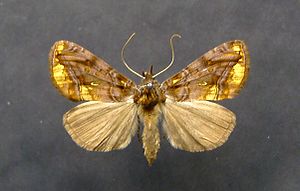Meadow rue gold owl
| Meadow rue gold owl | ||||||||||||
|---|---|---|---|---|---|---|---|---|---|---|---|---|

Meadow rue owl (Lamprotes c-aureum) |
||||||||||||
| Systematics | ||||||||||||
|
||||||||||||
| Scientific name | ||||||||||||
| Lamprotes c-aureum | ||||||||||||
| ( Knoch , 1781) |
The meadow rue gold owl ( Lamprotes c-aureum ) is a butterfly ( moth ) from the family of the owl butterflies (Noctuidae).
features
The meadow rue gold owl is a medium-sized butterfly with a wingspan of 36 to 40 millimeters. The forewings are dark brown, partly tinted purple. Ring and kidney defects are indistinct. The transverse lines are each double. There is a golden field on the inner edge of the outer transverse line. Most of the area between the double transverse line and the outer edge of the front edge is shiny gold. The tip of the cone blemishes and parts of the root field are also partially golden. The hind wings are brown-gray. The body of the butterfly is furry, especially in the front area, and there is a tuft of hair on the head. The eggs are yellowish white. The caterpillars reach a length of up to 35 millimeters and are unmistakable. They have only two pairs of ventral feet, are green with oblique spots bordered by wide white, and with conical back warts from the 4th to the 11th segment. The pupa is light green with a blue-black back and a slightly elongated trunk sheath. The cremaster is stalked and has two longer and some shorter hook-shaped bristles.
Geographical distribution and occurrence
The distribution area of the species stretches from southeast France across Central Europe, Northern Italy, the northern Balkan Peninsula across central Russia, the Caucasus, the southern Ural Mountains, southern Siberia, Mongolia to northern China. In the north the distribution area extends to southern Sweden and southern Finland. But it is missing in the British Isles. On the Pacific coast it is represented by the very similar sister species Lamprotes mikadina . The meadow rue gold owl is preferred in alluvial forests, floodplains, riverside areas and park landscapes sporadically or rarely. It can also occur more frequently in local biotopes. In the northern part of the range, the species can be found in the lowlands to the hill country. In the Alps, the species rises up to approx. 1200 meters and can be found there on mountain meadows with high grass cover. Especially in southern Europe, the species prefers the mountainous regions.
Phenology and way of life
The meadow rue gold owl occurs in one generation each year, from the end of June to the end of August. In warmer regions z. T. formed an incomplete second generation. The moths fly here from late May to September. The moths rest during the day and only become active at dusk. They visit flowers and suck nectar. The moths on Lavandula spica (syn. Of broad-leaved lavender ( Lavandula latifolia )), common adder's head ( Echium vulgare ) and common soapwort ( Saponaria officinalis ) were observed . They are attracted to artificial light sources. The eggs are laid in small numbers (approx. 7 to 10) on the underside of the leaves of the host plants. The caterpillars feed on the leaves of various rue and columbine species, such as B .:
- Akeleiblättrige meadow rue ( Thalictrum aquilegifolium )
- Yellow rue ( Thalictrum flavum )
- Columbine ( Aquilegia vulgaris )
The caterpillars rest in a hunched position on the underside of the leaves and are very well camouflaged there due to their shape, color and pattern and resemble bird droppings ( Kotmimese ). The young caterpillars overwinter and can be found from August to June of the following year. Pupation takes place in a silk-like web between the leaves of the host plant or, more rarely, on the ground.
Danger
The species is on the red list of endangered species in Germany. It is classified as endangered.
Synonyms
- Chrysoptera c-aureum
- Plusia c-aureum
swell
literature
- Günter Ebert (Hrsg.): The Butterflies of Baden-Württemberg Volume 6, Nachtfalter IV. Ulmer Verlag Stuttgart 1997 (Eulen (Noctuidae) 2nd part), ISBN 3-8001-3482-9
- Barry Goater, Lázló Ronkay, Michael Fibiger: Catocalinae & Plusiinae. - Noctuidae Europaeae, Volume 10. , Sorø, 2003, ISBN 87-89430-08-5
Individual evidence
- ↑ Goater et al., P. 219
- ↑ a b c d e Manfred Koch : We determine butterflies. Volume 3: Owls. 2nd, expanded edition. Neumann, Leipzig / Radebeul 1972, DNB 760072930 .
- ^ A b Walter Forster , Theodor A. Wohlfahrt : The butterflies of Central Europe. Volume 4: Owls. (Noctuidae). Franckh'sche Verlagshandlung, Stuttgart 1971, ISBN 3-440-03752-5 .
- ↑ after Goater et al., P. 219. However, this is confirmed by other authors, e.g. B. Steiner in Ebert, p. 112 doubted
- ↑ Heiko Bellmann : The new Kosmos butterfly guide. Butterflies, caterpillars and forage plants. Franckh-Kosmos, Stuttgart 2003, ISBN 3-440-09330-1 , p. 206.
- ↑ Federal Agency for Nature Conservation (Ed.): Red List of Endangered Animals in Germany. Landwirtschaftsverlag, Münster 1998, ISBN 978-3-89624-110-8